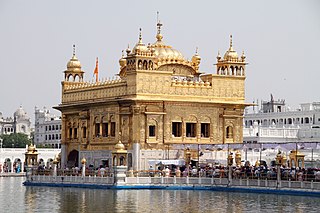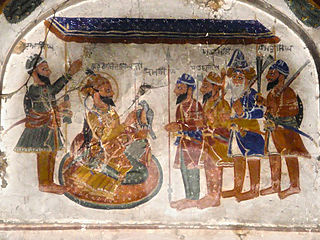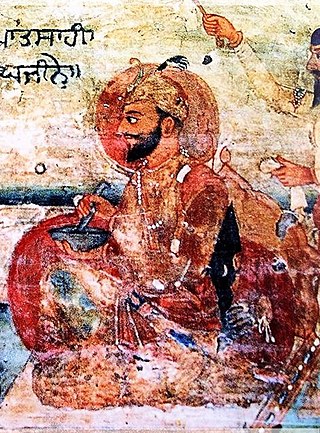
Sikhism, also known as Sikhi, or Sikh Dharma, is an Indian/Dharmic religion and philosophy that originated in the Punjab region of the Indian subcontinent, around the end of the 15th century CE. It is the most recently founded major organized faith and stands at fifth-largest worldwide, with about 25–30 million adherents.
A gurdwara is a place of assembly and worship for Sikhs. Sikhs also refer to gurdwaras as Gurdwara Sahib. People from all faiths are welcomed in gurdwaras. Each gurdwara has a Darbar Sahib where the Guru Granth Sahib is placed on a takhat in a prominent central position. Any congregant may recite, sing, and explain the verses from the Guru Granth Sahib, in the presence of the rest of the congregation.

The Guru Granth Sahib is the central holy religious scripture of Sikhism, regarded by Sikhs as the final, sovereign and eternal Guru following the lineage of the ten human gurus of the religion. The Adi Granth, its first rendition, was compiled by the fifth guru, Guru Arjan (1564–1606). Its compilation was completed on 29 August 1604 and first installed inside Golden Temple in Amritsar on 1 September 1604. Baba Buddha was appointed the first Granthi of the Golden Temple. Shortly afterwards Guru Hargobind added Ramkali Ki Vaar. Later, Guru Gobind Singh, the tenth Sikh guru, added hymns of Guru Tegh Bahadur to the Adi Granth and affirmed the text as his successor. This second rendition became known as the Guru Granth Sahib and is also sometimes referred to as the Adi Granth.
The following outline is provides an overview of Sikhism, or Sikhi.

Gurbani is a Sikh term, very commonly used by Sikhs to refer to various compositions by the Sikh Gurus and other writers of Guru Granth Sahib. In general, hymns in the central text of the Sikhs, the Guru Granth Sahib, are called Gurbani. Among Amritdhari Sikhs, a few texts from Dasam Granth which are read as Nitnem, like Tav-Prasad Savaiye and Chaupai, are also considered Gurbani. In Adi Granth, Gurbani is a sound which comes directly from the Supreme and the text is a written form of the same in worldly language and scripts. It is also called Guru´s Bani. Gurbani are explanations of qualities of the Primal Lord and Soul which a Sikh should comprehend and with which they can attain the supreme state.

The Dasam Granth is a collection of various manuscripts in Sikhism containing compositions attributed to Guru Gobind Singh. Guru Gobind Singh ordained the sacred text Guru Granth Sahib as his successor, eternally ending the line of human Gurus. It is the primary holy scripture of the Sikhs and regarded by Sikhs as the living embodiment of Ten Gurus. Bachittar Natak is a part of composition

Rehras Sahib, commonly known as So dar Rehras, is the daily evening prayer of the Sikhs and is part of Nitnem. It includes hymns from Guru Granth Sahib Ji and Dasam Granth Ji.

Nitnem is a collection of Sikh hymns (Gurbani) to be read minimally 3 different times of the day. These are mandatory and to be read by every Amritdhari Sikh as expressed in the Sikh Rehat Maryada. Optionally additional prayers may be added to a Sikh's nitnem. There are five hymns (Five Banis) to be done during Amrit Vela, the Rehras Sahib hymn for the evening and Kirtan Sohila for the night. The morning and evening prayers should be followed by an Ardaas.

Anand Sahib is a collection of hymns in Sikhism, written in the Ramkali Raag by Guru Amar Das Ji, the third Guru of the Sikhs. It appears on the pages 917 to 922 in Guru Granth Sahib Ji. The word Anand means complete happiness.

Panj Pyare refers to a gathered ad hoc quintet of five baptized (Amritdhari) Khalsa Sikhs who act as institutionalized leaders for the wider Sikh community.
Mohkam Singh, born Mohkam Chand, was one of the inaugural group of Panj Pyare, or the first Five Beloved of honoured memory in the Sikh tradition.

A Granthi is a person, female or male, of the Sikh religion who is a ceremonial reader of the Guru Granth Sahib, which is the holy book in Sikhism, often read to worshipers at Sikh temples called a Gurdwara. The name Granthi comes from the Sanskrit granthika, which means a relater or narrator. Any Sikh individual appointed the title of being a Granthi is considered a principal religious official of Sikhism. Although they are considered religious officials in Sikhism, they are not considered to be the equivalent of a priest, as the belief is that there are no such religious intermediaries.

The principal Sikh scripture is the Adi Granth, more commonly called the Guru Granth Sahib. The second most important scripture of the Sikhs is the Dasam Granth. Both of these consist of text which was written or authorised by the Sikh Gurus.
The principles of Sikhism state that women have the same souls as men and thus possess an equal right to cultivate their spirituality with equal chances of achieving salvation. Women in Sikhism participate in all religious, cultural, social, and secular activities including lead religious congregations, take part in the Akhand Path, perform Kirtan, perform Gatka and work as a Granthis.
The following list consists of concepts that are derived from both Sikh and Indian tradition. The main purpose of this list is to disambiguate multiple spellings, to make note of spellings no longer in use for these concepts, to define the concept in one or two lines, to make it easy for one to find and pin down specific concepts, and to provide a guide to unique concepts of Sikhism all in one place.
A takht, or taḵẖata, literally means a throne or seat of authority and is a spiritual and temporal centre of Sikhism. There are five takhts, which are five gurudwaras that have a very special significance for the Sikh community. Three are located in Punjab whilst the remaining two are located outside of it.

The 52 Hukams are a set of instruction in Sikhism set by Guru Gobind Singh in Nanded, Maharashtra, India in 1708. These edicts sum up the ideal way of life of the Khalsa and serve as a code of conduct for the Khalsa Panth. Members of the Khalsa aim to follow all the 52 edicts.
Sikhism has often been criticised by non-Sikhs regarding its texts, practices, and societal norms, but Sikhs and other scholars argue that these criticisms are flawed and are based on a biased and poor understanding of the texts, especially of the multiple languages used in the Sikh scriptures. They also argue that most western scholars who attempted to interpret eastern religious texts were missionaries and could not overcome the bias they carried with them, irrespective of whether they were translating the Quran, Vedas, Puranas or the Guru Granth Sahib. Guru Nanak rejected ritualistic worship and encouraged belief in one true God, Waheguru. The veneration and bowing to the Guru Granth Sahib, has often been interpreted by western scholars as akin to idolatry, as observed by the Hindu faith, which defeats the ideology of Guru Nanak. Other scholars dismiss Sikhism as, either consciously or spontaneously, a syncretism of the Hindu Bhakti and Muslim Sufi movements.

Amrit Sanskar is one of the four Sikh Sanskaars. The Amrit Sanskar is the initiation rite introduced by Guru Gobind Singh when he founded the Khalsa in 1699.
The 2015 Guru Granth Sahib desecration refers to a series of desecration incidents of the Sikh Guru Guru Granth Sahib and subsequent protests that took place in Punjab, India in October 2015, although it is known as the 2015 Guru Granth Sahib desecration it started from 2014 and continues till 2021. The first incident of desecration was reported from Bargari, Faridkot district, where 110 torn Angs of the holy Book were found on 12 October. On the early morning hours of 14 October, two Sikhs were peacefully protesting and were shot dead by the police as the protesters were sitting in demonstration.











